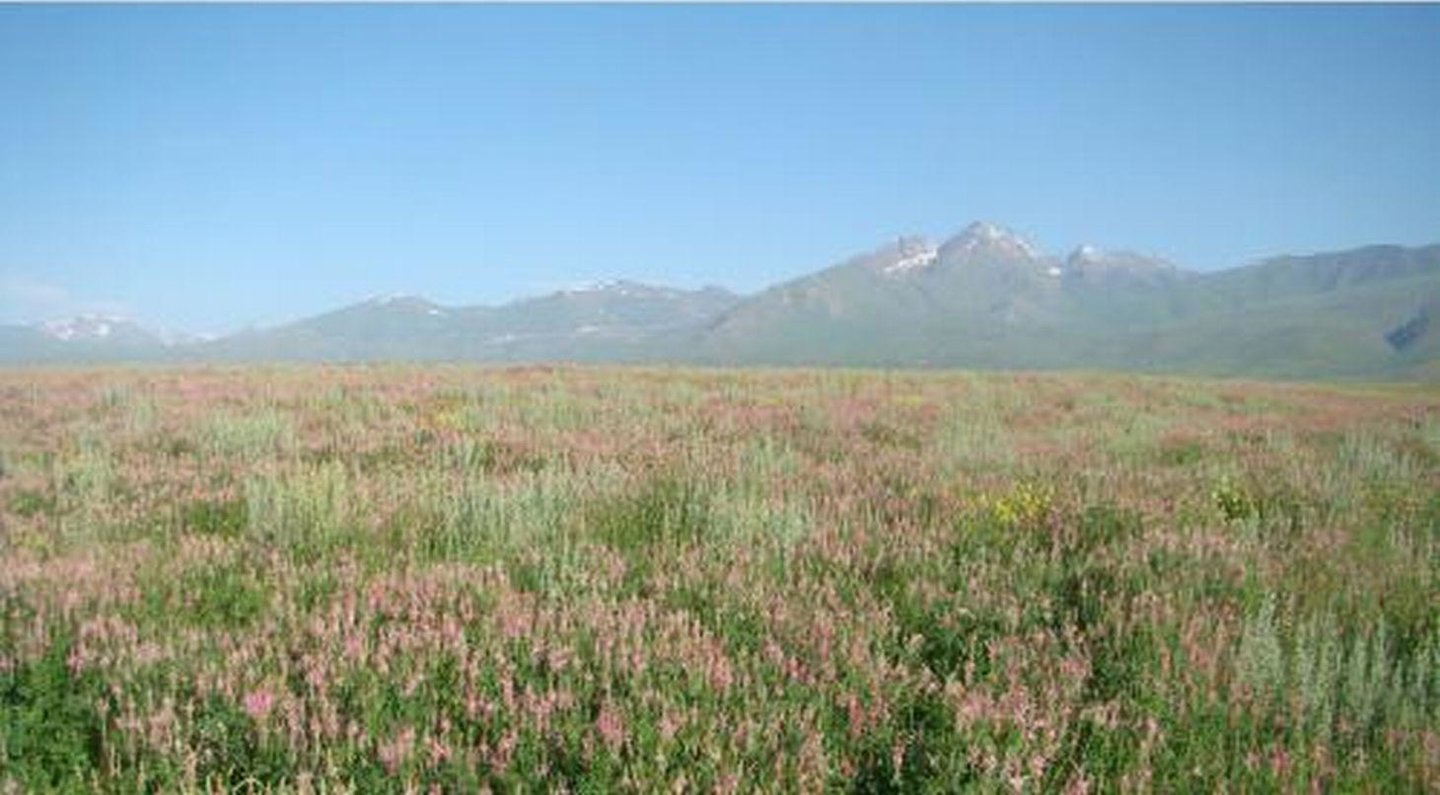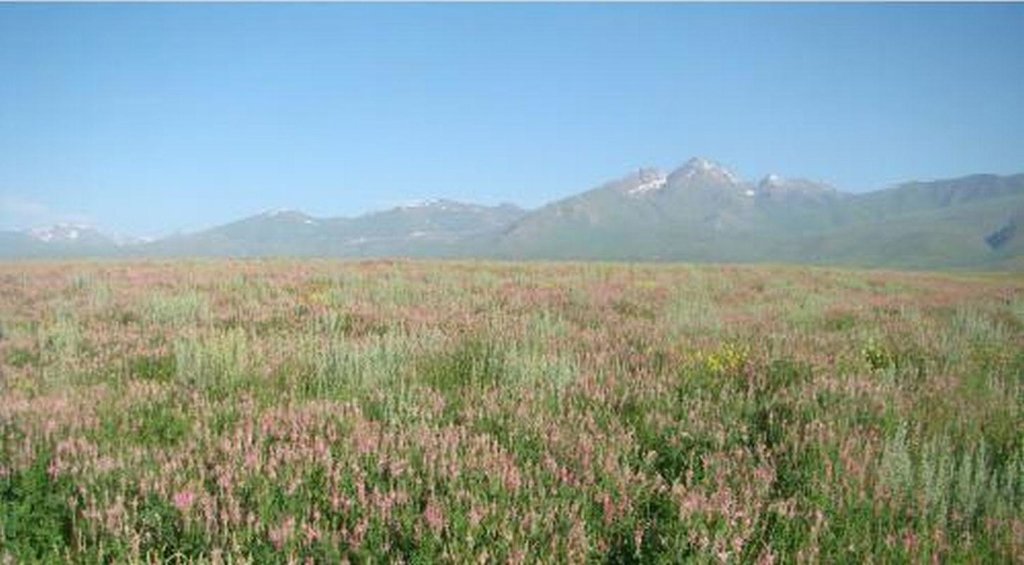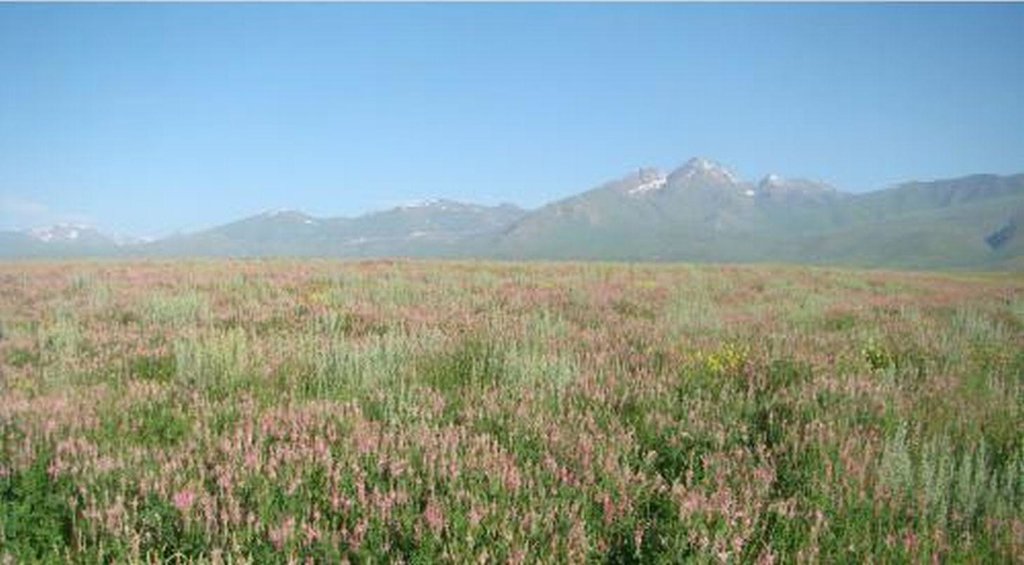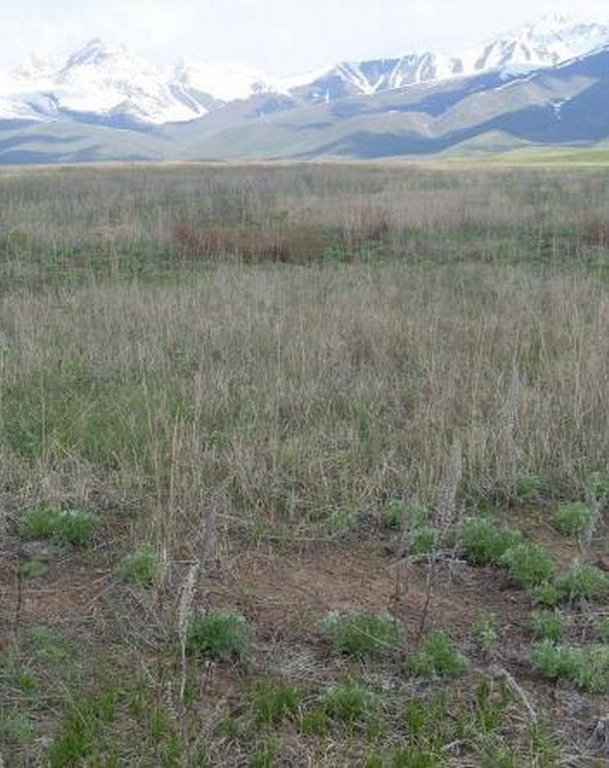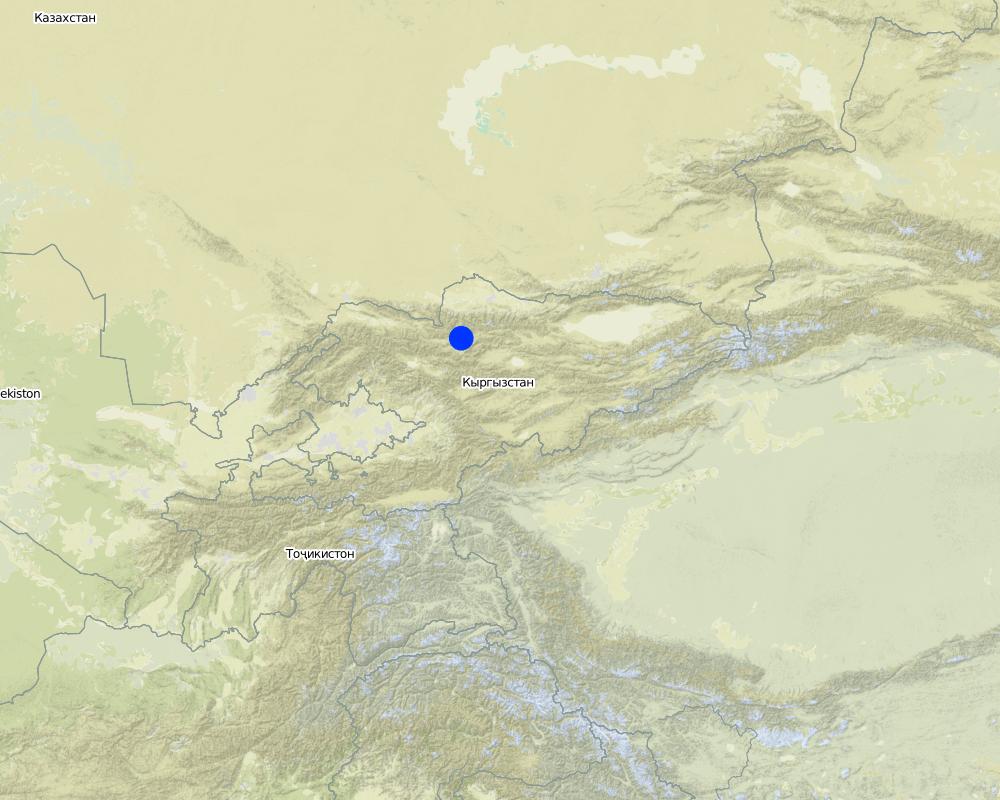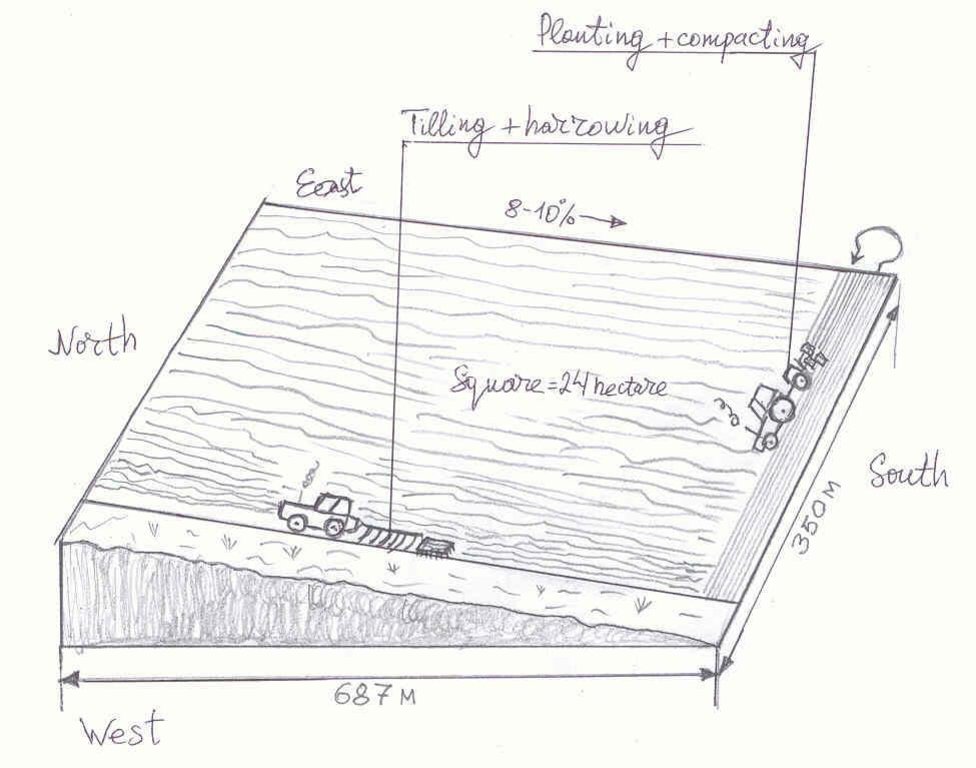Cultivation of sainfoin on high mountain pastures – Suusamyr Valley (in the frame of CACILM) [Kirghizistan]
- Création :
- Mise à jour :
- Compilateur : Abdybek Asanaliev
- Rédacteur : –
- Examinateurs : Deborah Niggli, Alexandra Gavilano
Kyrgyzstan - Central Asian Countries Initiative for Land Management (CACILM/ИСЦАУЗР)
technologies_963 - Kirghizistan
- Résumé complet en PDF
- Résumé complet en PDF pour impression
- Résumé complet dans le navigateur
- Résumé complet (non formaté)
- Cultivation of sainfoin on high mountain pastures – Suusamyr Valley (in the frame of CACILM): 27 décembre 2016 (inactive)
- Cultivation of sainfoin on high mountain pastures – Suusamyr Valley (in the frame of CACILM): 21 mars 2017 (inactive)
- Cultivation of sainfoin on high mountain pastures – Suusamyr Valley (in the frame of CACILM): 3 août 2017 (public)
Voir les sections
Développer tout Réduire tout1. Informations générales
1.2 Coordonnées des personnes-ressources et des institutions impliquées dans l'évaluation et la documentation de la Technologie
Personne(s)-ressource(s) clé(s)
exploitant des terres:
Ibraimov Azimjan
Farmer in Susamyr valley
Kirghizistan
exploitant des terres:
Usubaliev Baibek
996 (312) 566 318
b.usubaliev@up.elcat.kg
ELCAT
Toktanaliev Street, # 4 A, room # 212,
Kirghizistan
exploitant des terres:
Duishenaaly uulu Urmat
Suusamyr Village
Kirghizistan
Nom du projet qui a facilité la documentation/ l'évaluation de la Technologie (si pertinent)
Central Asian Countries Initiative for Land Management (CACILM I)1.3 Conditions relatives à l'utilisation par WOCAT des données documentées
Quand les données ont-elles été compilées (sur le terrain)?
14/01/2011
Le compilateur et la(les) personne(s) ressource(s) acceptent les conditions relatives à l'utilisation par WOCAT des données documentées:
Oui
1.4 Déclaration sur la durabilité de la Technologie décrite
Est-ce que la Technologie décrite ici pose problème par rapport à la dégradation des terres, de telle sorte qu'elle ne peut pas être déclarée comme étant une technologie de gestion durable des terres?
Non
2. Description de la Technologie de GDT
2.1 Courte description de la Technologie
Définition de la Technologie:
Conservation of soil fertility through the cultivation of sainfoin (perennial legume plants)
2.2 Description détaillée de la Technologie
Description:
The Suusamyr Plain is located in the South-West of Chui Valley. Generally, this zone, located at 2000-3800 meters above sea level is used by farmers as summer pastures. Farmers are practicing agro-pastoralism by grazing animals and at the same time producing winter fodder for their livestock. They cultivate mainly barley and sometimes perennial grass.
The territory of the local administration of the Aiyl Okrug “Suusamyr” includes 6645 hectares of arable land. In 2009 about 2500 hectares were cultivated with cereals (including 1950 ha of barley) and 250 ha with sainfoin. As a result of the monoculture of cereals, weeds, pests, and insects accumulate on the fields and the soil fertility is declining. These are direct and indirect indicators of soil degradation.
The main cultivated perennial legume is sainfoin. However,farmers are short of sainfoin seeds. Most of them cultivate sainfoin for hay making and consider the seed production as non profitable.
Fallow is maintained free from weed during the vegetation season. As fallow is weed free and accumulates the soil moisture it has synergy effect to harvest high yield of barley grain. This fallow is kept during one vegetation season and applied by other farmers during next season. Crop rotation cycle is 5 years including 1 year-fallow period (1year-fallow period, 1year for barley planting and 3 years for sainfoin planting). Barley is planted into the fallow.
Sainfoin improves the soil structure as a result of high rizo-biomasses (237-333 kg/ha). Sainfoin is able to accumulate 194 -178 kg/ha of biological nitrogen providing sufficient nitrogen fertilization for two consecutive cropping seasons. Sainfoin can be cultivated at altitudes from 700 to 3400 m above sea level (G. Balian, 2004). Sainfoin is a high nectar producting crop, allowing farmers to produce 150 kg of honey from 1 hectare of sainfoin during a vegetation period. As the result of insect pollination, an increase in seed production of between 100 and 200 kg/ha has been observed.
Purpose of the Technology: Soil fertility conservation through crop rotation of barley with the perennial grass sainfoin (Onobrichis sativa).
Farmer Ibraimov Azimjan has 25 hectares of private land and rents other land from neighboring farmers. UNDP’s project procured seeds of sainfoin and covered expenditures for tillage and planting. The farmer’s responsibility is to distribute produced seeds among other farmers which are able to expand their areas under sainfoin cultivation. The farmers maintains crop rotation.
Fields are located in the foothills at an elevation of 2038-2200 m above sea level. Plowing is conducted along the slope. But planting is done across to the tilling direction, horizontally along the field (contour planting drilling). This technology increases vegetation cover and after harvesting stubbles remain
Agriculture in Suusamyr Valley is based on animal husbandry which is kept on pastures during three seasons (spring, summer and autumn). But farmers practice agro-pastorals. They have private arable land and produce cereals and forage crops. The Local Government “Suusamyr” has 6645 hectares of arable land including 561 hectares from the Distribution Found (state regulated land). Farmers are not subsidized by the Government.
The farmer Ibraimov Azimjan has 25 hectares of private land and rents other land from the neighboring farmers. In 2009 UNDP’s project procured basic seeds of sainfoin and covered the expenditures for tillage and planting. UNDP’s project organized several workshops for farmers on technology of cereals and forage crops cultivation. Project manager also had finance support in field inspection of sainfoin seed and barley.
Farmer’s responsibility is to distribute seed among other farmers which able to expand their areas under sainfoin. Farmer has resources to guard the field from grazing of animals during the vegetation period, harvest and transportation of seed. Azimjan also organized the seed cleaning and storage. Project’s management developed the rules on seed distributions and sale.
The farmer should produce sainfoin and barley in order to get benefit. Farmer’s responsibility is to distribute seed to other farmers which able to expand the area under sainfoin and barley. Name of sainfoin variety is “Belek”, barley variety is “Kylym”, they are developed in research centers of Kyrgyz Republic.
The population of the Aiyl Okrug “Suusamyr” is 6400. The Local Government has no human resources for field activities. There are six villages at the territory of this Local Government. All fields and villages are connected by dirt roads. The electricity is supplied on regularly basis. People have drinking water supplies.
Farmer’s fields are located at foothills of 2038-2200 m above sea level. The type of land use is rainfed. Some irrigated channels which were developed in Soviet time are destroyed now. The fields are infested mainly with wild Oat, Couch-grass, spp. pigweed, wormwood and others.
The farmers cultivate cereals as monoculture. Some of them plant the sainfoin. Additionally, farmers cultivate potato on a total area of 180-200 hectares. The varieties are from local breeders (Nevsky, Cardinal) and introduced varieties from seed Firm “Agrico” and “NZPC” (Picasso, Sante and Mondial).
The main type of soil is chestnut (light chestnut soil and dark chestnut soil). The potential fertility of these soils is high but due to the lack of crop rotation, plant protection activities, fertilizer application, soil degradation is going on. There are no soil maps in the office of local administration except for those which were developed during the Soviet time.
2.3 Photos de la Technologie
2.5 Pays/ région/ lieux où la Technologie a été appliquée et qui sont couverts par cette évaluation
Pays:
Kirghizistan
Région/ Etat/ Province:
Kyrgyz Republic, Chui oblast
Autres spécifications du lieu:
Jayl district
Commentaires:
Boundary points of the Technology area: The sainfoin is cultivated on mountain pastures from 800 meters to 3000 meters above sea level
Map
×2.6 Date de mise en œuvre de la Technologie
Si l'année précise est inconnue, indiquez la date approximative: :
- il y a moins de 10 ans (récemment)
2.7 Introduction de la Technologie
Spécifiez comment la Technologie a été introduite: :
- par le biais de projets/ d'interventions extérieures
Commentaires (type de projet, etc.) :
The Technology was developed by the Kyrgyz Livestock and Pasture Research Institute and applied by the UNDP Project "Demonstration Sustainable Mountain Pasture Management in Suusamyr Valley, Kyrgyzstan"
3. Classification de la Technologie de GDT
3.1 Principal(aux) objectif(s) de la Technologie
- créer un impact économique positif
3.2 Type(s) actuel(s) d'utilisation des terres, là où la Technologie est appliquée

Terres cultivées
- Cultures annuelles
- Cultures pérennes (non ligneuses)

Pâturages
Pâturage extensif:
- Semi-nomadisme/ pastoralisme
- Ranching
Pâturage intensif/ production fourragère :
- Prairies améliorées
- agro-pastoralism
Commentaires:
Major land use problems (compiler’s opinion): Decline of soil fertility due to longstanding cultivation of barley on the field. Annual conventional plowing is affecting the mineralization of soil humus.
Major land use problems (land users’ perception): Decline of barley yield. The quality of barley grain also is declining.
Future (final) land use (after implementation of SLM Technology): Cropland: Cp: Perennial (non-woody) cropping
Livestock is grazing on crop residues
3.3 Informations complémentaires sur l'utilisation des terres
Approvisionnement en eau des terres sur lesquelles est appliquée la Technologie:
- mixte: pluvial-irrigué
Nombre de période de croissance par an: :
- 1
Précisez:
Longest growing period in days: 120, Longest growing period from month to month: April - August
Densité d'élevage/ chargement (si pertinent):
25-50 LU /km2
3.5 Diffusion de la Technologie
Spécifiez la diffusion de la Technologie:
- répartie uniformément sur une zone
Si la Technologie est uniformément répartie sur une zone, indiquez la superficie couverte approximative:
- 0,1-1 km2
Commentaires:
Total area covered by the SLM Technology is 0,24 m2.
3.6 Mesures de GDT constituant la Technologie

pratiques agronomiques
- A1: Couverture végétale/ du sol
- A3: Traitement de la couche superficielle du sol

pratiques végétales
- V2: Herbes et plantes herbacées pérennes
3.7 Principaux types de dégradation des terres traités par la Technologie

dégradation chimique des sols
- Cn: baisse de la fertilité des sols et réduction du niveau de matière organique (non causée par l’érosion)

dégradation biologique
- Bc: réduction de la couverture végétale
- Bh: perte d’habitats
Commentaires:
Main causes of degradation: soil management (Lack of fertilizes), over-exploitation of vegetation for domestic use, Heavy / extreme rainfall (intensity/amounts) (Usually in dry weather plants have a vertical appearance. After heavy gales they lose their vetical standing and they droop. This is lodging. During lodginh of plants the yield of seed is decreasing.), land tenure
Secondary causes of degradation: crop management (annual, perennial, tree/shrub) (As a result of the monoculture of cereals, weeds, pests, and insects accumulate on the fields and the soil fertility is declining.), other human induced causes (specify) (inappropriate soil management)
3.8 Prévention, réduction de la dégradation ou réhabilitation des terres dégradées
Spécifiez l'objectif de la Technologie au regard de la dégradation des terres:
- réduire la dégradation des terres
- restaurer/ réhabiliter des terres sévèrement dégradées
4. Spécifications techniques, activités, intrants et coûts de mise en œuvre
4.1 Dessin technique de la Technologie
4.2 Spécification/ explications techniques du dessin technique
Fields are located on South exposition of the foothills of the Kyrgyz Ala-Too Mountains in the Northern part of the Suusamyr valley. The length of the sainfoin field is 687 meters, and its width is 350 meters. Slope steepness is 8-10 %.
Tilling is conducted along the slope by a tractor K-700, with harrowing being conducted at the same time. The depth of tilling is 20-22 cm. Planting is conducted across to plowing direction. The date for sainfoin sowing is the first ten days of May. The seeds required are 80 kg/ha. Depth of sowing is 4 cm. This field is situated 8 kilometers from central Suusamyr village, reachable on a bad dirt road.
Location: Suusamyr Valley. Jaiyl raion / Chui oblast / Kyrgyzstan
Date: 11.01.2011
Technical knowledge required for field staff / advisors: high (Special training is requested)
Technical knowledge required for land users: low (Field demonstration is needed)
Main technical functions: control of dispersed runoff: impede / retard, stabilisation of soil (eg by tree roots against land slides), increase in organic matter, increase in nutrient availability (supply, recycling,…)
Secondary technical functions: improvement of subsoil structure (hardpan)
Vegetative measure: field planted by perennual grass
Vegetative material: C : perennial crops
Number of plants per (ha): 3000000
Spacing between rows / strips / blocks (m): 0.15
Width within rows / strips / blocks (m): 0.15
Vegetative measure: Vegetative material: C : perennial crops
Perennial crops species: Sainfoin os sowed with planting machine C3-3.6. The distance between colters is 15 cm.
4.3 Informations générales sur le calcul des intrants et des coûts
autre/ monnaie nationale (précisez):
KGS
Indiquer le taux de change du dollars en monnaie locale (si pertinent): 1 USD= :
45,0
Indiquez le coût salarial moyen de la main d'œuvre par jour:
8.00
4.4 Activités de mise en place/ d'établissement
| Activité | Type de mesures | Calendrier | |
|---|---|---|---|
| 1. | Tilling | Végétale | End of April. Once in 3 years |
| 2. | Planting | Végétale | End of April. Once in 3 years |
4.5 Coûts et intrants nécessaires à la mise en place
| Spécifiez les intrants | Unité | Quantité | Coûts par unité | Coût total par intrant | % des coût supporté par les exploitants des terres | |
|---|---|---|---|---|---|---|
| Main d'œuvre | establishment costs | hectare | 1,0 | 187,0 | 187,0 | |
| Main d'œuvre | labour | person/hour | 0,8 | 128,0 | 102,4 | 100,0 |
| Matériel végétal | seeds | hecatre | 1,0 | 108,0 | 108,0 | |
| Matériel végétal | seeds | kg | 75,0 | 2600,0 | 195000,0 | |
| Autre | fuel | liter | 58,0 | 321,0 | 18618,0 | |
| Coût total de mise en place de la Technologie | 214015,4 | |||||
Commentaires:
Duration of establishment phase: 1 month(s)
4.6 Activités d'entretien/ récurrentes
| Activité | Type de mesures | Calendrier/ fréquence | |
|---|---|---|---|
| 1. | Harvesting | Végétale | annually |
| 2. | Cleaning of seed | Végétale | annually |
| 3. | Cleaning of seed | Végétale |
4.7 Coûts et intrants nécessaires aux activités d'entretien/ récurrentes (par an)
Commentaires:
Machinery/ tools: Tractor MTZ-80, Self-Proppeled Combine Enisey-600, Seed Cleaning Machine SM-4
The above costs were affected by the length of the field and number of turn points during tilling and planting.
4.8 Facteurs les plus importants affectant les coûts
Décrivez les facteurs les plus importants affectant les coûts :
The price of sainfoin seeds is very high. The slope is increasing the fuel consumption of the tractor, and prices for fuel are raising. Contour tilling (also planting) by big tractor (K-700) is further increasing fuel consumption, because the number of turning-points are increased. Soil depth is not increasing cost in a major way, because soil structure in the area is comparatively good and the tractor is powerful.
All costs are calculated for 1 hectare of sainfoin. National currency is KGS. Exchange rate was approximately 45 KGS for 1 US Dollar in 2009 and 2010.
5. Environnement naturel et humain
5.1 Climat
Précipitations annuelles
- < 250 mm
- 251-500 mm
- 501-750 mm
- 751-1000 mm
- 1001-1500 mm
- 1501-2000 mm
- 2001-3000 mm
- 3001-4000 mm
- > 4000 mm
Zone agro-climatique
- subhumide
Thermal climate class: temperate
5.2 Topographie
Pentes moyennes:
- plat (0-2 %)
- faible (3-5%)
- modéré (6-10%)
- onduleux (11-15%)
- vallonné (16-30%)
- raide (31-60%)
- très raide (>60%)
Reliefs:
- plateaux/ plaines
- crêtes
- flancs/ pentes de montagne
- flancs/ pentes de colline
- piémonts/ glacis (bas de pente)
- fonds de vallée/bas-fonds
Zones altitudinales:
- 0-100 m
- 101-500 m
- 501-1000 m
- 1001-1500 m
- 1501-2000 m
- 2001-2500 m
- 2501-3000 m
- 3001-4000 m
- > 4000 m
5.3 Sols
Profondeur moyenne du sol:
- très superficiel (0-20 cm)
- superficiel (21-50 cm)
- modérément profond (51-80 cm)
- profond (81-120 cm)
- très profond (>120 cm)
Texture du sol (de la couche arable):
- grossier/ léger (sablonneux)
- moyen (limoneux)
Texture du sol (> 20 cm sous la surface):
- grossier/ léger (sablonneux)
- moyen (limoneux)
Matière organique de la couche arable:
- abondant (>3%)
- moyen (1-3%)
Si disponible, joignez une description complète du sol ou précisez les informations disponibles, par ex., type de sol, pH/ acidité du sol, capacité d'échange cationique, azote, salinité, etc.
medium-high soil fertility, soil water storage = medium, soil drainage = good
5.4 Disponibilité et qualité de l'eau
Profondeur estimée de l’eau dans le sol:
5-50 m
Disponibilité de l’eau de surface:
bonne
Qualité de l’eau (non traitée):
eau potable
La salinité de l'eau est-elle un problème? :
Non
5.5 Biodiversité
Diversité des espèces:
- moyenne
Diversité des habitats:
- moyenne
Commentaires et précisions supplémentaires sur la biodiversité:
Earthworms and gnawing animals inhabit on the field
5.6 Caractéristiques des exploitants des terres appliquant la Technologie
Sédentaire ou nomade:
- Semi-nomade
- Nomade
Orientation du système de production:
- subsistance (auto-approvisionnement)
- mixte (de subsistance/ commercial)
Revenus hors exploitation:
- moins de 10% de tous les revenus
Niveau relatif de richesse:
- moyen
- très riche
Individus ou groupes:
- groupe/ communauté
Niveau de mécanisation:
- mécanisé/ motorisé
Genre:
- femmes
- hommes
Indiquez toute autre caractéristique pertinente des exploitants des terres:
Land users applying the Technology are mainly common / average land users
Difference in the involvement of women and men: This technology is very strongly supported by Pasture Users Association, who is interesting in improving forage quantity and quality. Sainfoin's hay has high protein content in comparison with natural hay. Therefore the association is interested in expansion of sainfoin fields.
Population density: < 10 persons/km2
Annual population growth: 1% - 2%
Off-farm income specification: Some farmers sell agricultural and processing products in the shops located along the highway Bishkek-Osh and in the villages. Some of the villagers provide taxi services from Suusamyr to Bishkek.
5.7 Superficie moyenne des terres détenues ou louées par les exploitants appliquant la Technologie
- < 0,5 ha
- 0,5-1 ha
- 1-2 ha
- 2-5 ha
- 5-15 ha
- 15-50 ha
- 50-100 ha
- 100-500 ha
- 500-1 000 ha
- 1 000-10 000 ha
- > 10 000 ha
Cette superficie est-elle considérée comme de petite, moyenne ou grande dimension (en se référant au contexte local)?
- moyenne dimension
5.8 Propriété foncière, droits d’utilisation des terres et de l'eau
Propriété foncière:
- état
- individu, avec titre de propriété
Droits d’utilisation des terres:
- individuel
Droits d’utilisation de l’eau:
- communautaire (organisé)
5.9 Accès aux services et aux infrastructures
santé:
- pauvre
- modéré
- bonne
éducation:
- pauvre
- modéré
- bonne
assistance technique:
- pauvre
- modéré
- bonne
emploi (par ex. hors exploitation):
- pauvre
- modéré
- bonne
marchés:
- pauvre
- modéré
- bonne
énergie:
- pauvre
- modéré
- bonne
routes et transports:
- pauvre
- modéré
- bonne
eau potable et assainissement:
- pauvre
- modéré
- bonne
services financiers:
- pauvre
- modéré
- bonne
Extension Service:
- pauvre
- modéré
- bonne
6. Impacts et conclusions
6.1 Impacts sur site que la Technologie a montrés
Impacts socio-économiques
Production
production agricole
Quantité avant la GDT:
19 c/ha
Quantité après la GDT:
23 c/ha
production fourragère
Quantité avant la GDT:
500 bales
Quantité après la GDT:
550 bales
qualité des fourrages
Revenus et coûts
dépenses pour les intrants agricoles
Quantité avant la GDT:
0
Quantité après la GDT:
24 ha
diversité des sources de revenus
Impacts socioculturels
sécurité alimentaire/ autosuffisance
opportunités culturelles
institutions communautaires
Quantité avant la GDT:
0
Quantité après la GDT:
1
apaisement des conflits
Quantité avant la GDT:
0
Quantité après la GDT:
2 training
Impacts écologiques
Cycle de l'eau/ ruissellement
ruissellement de surface
Sols
couverture du sol
Quantité avant la GDT:
80%
Quantité après la GDT:
95%
compaction du sol
matière organique du sol/ au dessous du sol C
Biodiversité: végétale, animale
diversité des habitats
6.2 Impacts hors site que la Technologie a montrés
capacité tampon/de filtration
dommages sur les champs voisins
Quantité après la GDT:
5ha
Commentaires/ spécifiez:
Project recruts a security guard to protect sainfoin field since May. And at the same time he watches the neighbours fields.Therefore damage on it is reduced.
Honey collection is improved
6.3 Exposition et sensibilité de la Technologie aux changements progressifs et aux évènements extrêmes/catastrophes liés au climat (telles que perçues par les exploitants des terres)
Changements climatiques progressifs
Changements climatiques progressifs
| Saison | Type de changements/ extrêmes climatiques | Comment la Technologie fait-elle face à cela? | |
|---|---|---|---|
| températures annuelles | augmente | pas bien |
Extrêmes climatiques (catastrophes)
Catastrophes météorologiques
| Comment la Technologie fait-elle face à cela? | |
|---|---|
| pluie torrentielle locale | bien |
Catastrophes climatiques
| Comment la Technologie fait-elle face à cela? | |
|---|---|
| sécheresse | bien |
Catastrophes hydrologiques
| Comment la Technologie fait-elle face à cela? | |
|---|---|
| inondation générale (rivière) | pas bien |
Autres conséquences liées au climat
Autres conséquences liées au climat
| Comment la Technologie fait-elle face à cela? | |
|---|---|
| réduction de la période de croissance | pas bien |
6.4 Analyse coûts-bénéfices
Quels sont les bénéfices comparativement aux coûts de mise en place (du point de vue des exploitants des terres)?
Rentabilité à court terme:
très positive
Rentabilité à long terme:
très positive
Quels sont les bénéfices comparativement aux coûts d'entretien récurrents (du point de vue des exploitants des terres)?
Rentabilité à court terme:
positive
Rentabilité à long terme:
positive
6.5 Adoption de la Technologie
- cas isolés/ expérimentaux
Parmi tous ceux qui ont adopté la Technologie, combien d'entre eux l'ont fait spontanément, à savoir sans recevoir aucune incitation matérielle ou aucun paiement?
- 0-10%
Commentaires:
1% of land user families have adopted the Technology with external material support
1 land user families have adopted the Technology with external material support
Comments on acceptance with external material support: Saifoin seed was provided to farmers with lower price than commercially available seeds.
Comments on spontaneous adoption: There is little trend towards (growing) spontaneous adoption of the technology.
There is a little trend towards spontaneous adoption of the Technology. Some farmers are aware about the production of high quality forage and want to be ready to be protected from drought. During drought periods the yield of natural vegetation is less, but the yield of sainfoin’ is constant.
6.7 Points forts/ avantages/ possibilités de la Technologie
| Points forts/ avantages/ possibilités du point de vue de l'exploitant des terres |
|---|
| Keeping the fields as fallow is not profitable for ordinary farmers. It can be done by rich farmers. |
| There is need in subsidies from the Government in order to distribute cereals and perennial legume seed. |
| If there is enough fuel and seed farmers can cultivate sainfoin everywhere, it is very good technology. |
| Points forts/ avantages/ possibilités du point de vue du compilateur ou d'une autre personne ressource clé |
|---|
| The winter is very hard in Suusamyr Valley and livestock need enough and quality forage. Sainfoin hay contains high level of protein. |
| Natural vegetation yields for hay making is not so big particularly in drought period. Sainfoin is very productive crop. |
| Rizo biomass of sainfoin is big and it accumulates the nitrogen. Sainfoin improves the soil fertility. |
| Sainfoin is income generating crop because after harvesting of seed sainfoin the straw can be also sold by farmers at the price of 50 som for one hay bale |
| This Technology also protects the soil surface from the erosion in the result of strong density of plants. |
6.8 Faiblesses/ inconvénients/ risques de la Technologie et moyens de les surmonter
| Faiblesses/ inconvénients/ risques du point de vue de l’exploitant des terres | Comment peuvent-ils être surmontés? |
|---|---|
| Poor farmer is not interested in the Conservation Technology | Awareness raising of the poor farmers is necessary |
| We are having not enough knowledge about the soil conservation possibility legumes | To organize the training of farmers. |
| State legislation about soil protection is not maintained by Local Government and farmers | To monitor the observation of legislation by land users and local authorities |
| There should be Soil fertility protection service. | The Government should finance the establishment of service on soil fertility protection. |
| Faiblesses/ inconvénients/ risques du point de vue du compilateur ou d'une autre personne ressource clé | Comment peuvent-ils être surmontés? |
|---|---|
| Lack of good credit system for farmers SWCT. | To lower interest rates of credits while lending farmers for implementation of the Conservation Technology |
| Comparatively high price of certified sainfoin seeds are not available for farmers | Usage of not certified seed by farmers leads to poor yields of sainfoin and cereals. To ensure the supply of high quality seed through distributers’ centers |
| Farmers need special knowledge in order to produce sainfoin seed | To conduct trainings for farmers on seed production technologies. |
|
To consolidate farmers about the effect of sainfoin cultivation for soil fertility some scientists have to do on farm demonstration plots |
Extension services should organize demonstration fields in villages. |
7. Références et liens
7.1 Méthodes/ sources d'information
- visites de terrain, enquêtes sur le terrain
- interviews/entretiens avec les exploitants des terres
7.2 Références des publications disponibles
Titre, auteur, année, ISBN:
Usubaliev B. Annual project activity’s report. “Demonstration sustainable mountains pasture management in the Suusamyr Valley. Kyrgyzstan”. UNDP.- Kyrgyzsran., 2010. Bishkek.
Disponible à partir d'où? Coût?
Project office
Titre, auteur, année, ISBN:
Duishenaaly uulu Urmat.- Report of land management specialist of the “Local Gogernment Suusamyr”, 2010
Disponible à partir d'où? Coût?
Suusamyr Village
Titre, auteur, année, ISBN:
Bekganov Nurkan.- Report of local mobilization specialist of the UNDP project.- 2010
Disponible à partir d'où? Coût?
Suusamyr Village.
Titre, auteur, année, ISBN:
Amankulov Kubanychbek.- Report of statistics specialist of the “Local Gogernment Suusamyr”, 2010
Disponible à partir d'où? Coût?
.Suusamyr Village
Liens et modules
Développer tout Réduire toutLiens
Aucun lien
Modules
Aucun module trouvé


